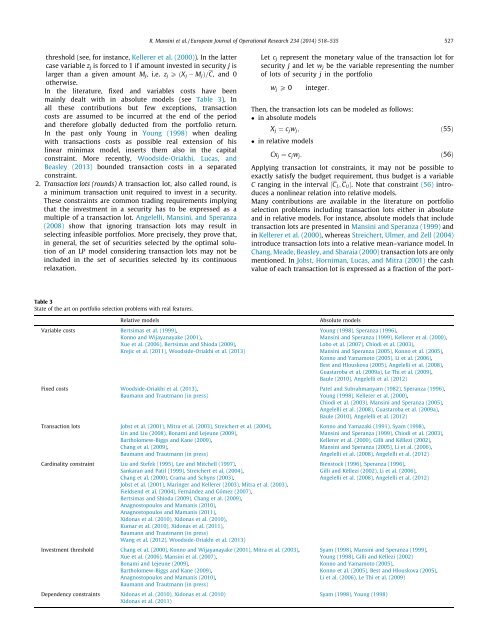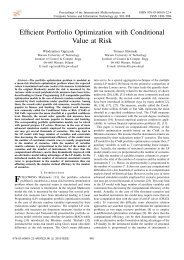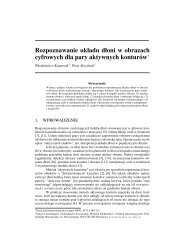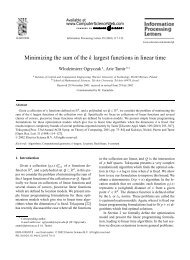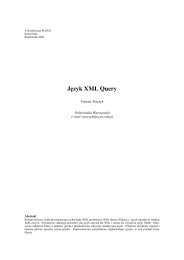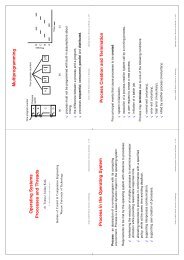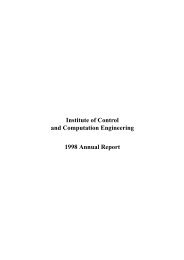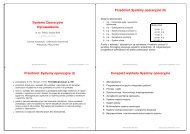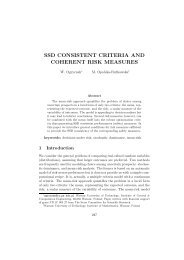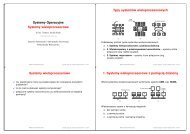Twenty Years of Linear Programming Based Portfolio Optimization
Twenty Years of Linear Programming Based Portfolio Optimization
Twenty Years of Linear Programming Based Portfolio Optimization
Create successful ePaper yourself
Turn your PDF publications into a flip-book with our unique Google optimized e-Paper software.
R. Mansini et al. / European Journal <strong>of</strong> Operational Research 234 (2014) 518–535 527<br />
threshold (see, for instance, Kellerer et al. (2000)). In the latter<br />
case variable z j is forced to 1 if amount invested in security j is<br />
larger than a given amount M j , i.e. z j P ðX j M j Þ=C, and 0<br />
otherwise.<br />
In the literature, fixed and variables costs have been<br />
mainly dealt with in absolute models (see Table 3). In<br />
all these contributions but few exceptions, transaction<br />
costs are assumed to be incurred at the end <strong>of</strong> the period<br />
and therefore globally deducted from the portfolio return.<br />
In the past only Young in Young (1998) when dealing<br />
with transactions costs as possible real extension <strong>of</strong> his<br />
linear minimax model, inserts them also in the capital<br />
constraint. More recently, Woodside-Oriakhi, Lucas, and<br />
Beasley (2013) bounded transaction costs in a separated<br />
constraint.<br />
2. Transaction lots (rounds) A transaction lot, also called round, is<br />
a minimum transaction unit required to invest in a security.<br />
These constraints are common trading requirements implying<br />
that the investment in a security has to be expressed as a<br />
multiple <strong>of</strong> a transaction lot. Angelelli, Mansini, and Speranza<br />
(2008) show that ignoring transaction lots may result in<br />
selecting infeasible portfolios. More precisely, they prove that,<br />
in general, the set <strong>of</strong> securities selected by the optimal solution<br />
<strong>of</strong> an LP model considering transaction lots may not be<br />
included in the set <strong>of</strong> securities selected by its continuous<br />
relaxation.<br />
Let c j represent the monetary value <strong>of</strong> the transaction lot for<br />
security j and let w j be the variable representing the number<br />
<strong>of</strong> lots <strong>of</strong> security j in the portfolio<br />
w j P 0<br />
integer:<br />
Then, the transaction lots can be modeled as follows:<br />
in absolute models<br />
X j ¼ c j w j ;<br />
in relative models<br />
Cx j ¼ c j w j :<br />
ð55Þ<br />
ð56Þ<br />
Applying transaction lot constraints, it may not be possible to<br />
exactly satisfy the budget requirement, thus budget is a variable<br />
C ranging in the interval ½C L ; C U Š. Note that constraint (56) introduces<br />
a nonlinear relation into relative models.<br />
Many contributions are available in the literature on portfolio<br />
selection problems including transaction lots either in absolute<br />
and in relative models. For instance, absolute models that include<br />
transaction lots are presented in Mansini and Speranza (1999) and<br />
in Kellerer et al. (2000), whereas Streichert, Ulmer, and Zell (2004)<br />
introduce transaction lots into a relative mean–variance model. In<br />
Chang, Meade, Beasley, and Sharaia (2000) transaction lots are only<br />
mentioned. In Jobst, Horniman, Lucas, and Mitra (2001) the cash<br />
value <strong>of</strong> each transaction lot is expressed as a fraction <strong>of</strong> the port-<br />
Table 3<br />
State <strong>of</strong> the art on portfolio selection problems with real features.<br />
Relative models<br />
Absolute models<br />
Variable costs Bertsimas et al. (1999), Young (1998), Speranza (1996),<br />
Konno and Wijayanayake (2001), Mansini and Speranza (1999), Kellerer et al. (2000),<br />
Xue et al. (2006), Bertsimas and Shioda (2009), Lobo et al. (2007), Chiodi et al. (2003),<br />
Krejic et al. (2011), Woodside-Oriakhi et al. (2013) Mansini and Speranza (2005), Konno et al. (2005),<br />
Konno and Yamamoto (2005), Li et al. (2006),<br />
Best and Hlouskova (2005), Angelelli et al. (2008),<br />
Guastaroba et al. (2009a), Le Thi et al. (2009),<br />
Baule (2010), Angelelli et al. (2012)<br />
Fixed costs Woodside-Oriakhi et al. (2013), Patel and Subrahmanyam (1982), Speranza (1996),<br />
Baumann and Trautmann (in press) Young (1998), Kellerer et al. (2000),<br />
Chiodi et al. (2003), Mansini and Speranza (2005),<br />
Angelelli et al. (2008), Guastaroba et al. (2009a),<br />
Baule (2010), Angelelli et al. (2012)<br />
Transaction lots Jobst et al. (2001), Mitra et al. (2003), Streichert et al. (2004), Konno and Yamazaki (1991), Syam (1998),<br />
Lin and Liu (2008), Bonami and Lejeune (2009), Mansini and Speranza (1999), Chiodi et al. (2003),<br />
Bartholomew-Biggs and Kane (2009), Kellerer et al. (2000), Gilli and Këllezi (2002),<br />
Chang et al. (2009), Mansini and Speranza (2005), Li et al. (2006),<br />
Baumann and Trautmann (in press) Angelelli et al. (2008), Angelelli et al. (2012)<br />
Cardinality constraint Liu and Stefek (1995), Lee and Mitchell (1997), Bienstock (1996), Speranza (1996),<br />
Sankaran and Patil (1999), Streichert et al. (2004), Gilli and Këllezi (2002), Li et al. (2006),<br />
Chang et al. (2000), Crama and Schyns (2003), Angelelli et al. (2008), Angelelli et al. (2012)<br />
Jobst et al. (2001), Maringer and Kellerer (2003), Mitra et al. (2003),<br />
Fieldsend et al. (2004), Fernández and Gómez (2007),<br />
Bertsimas and Shioda (2009), Chang et al. (2009),<br />
Anagnostopoulos and Mamanis (2010),<br />
Anagnostopoulos and Mamanis (2011),<br />
Xidonas et al. (2010), Xidonas et al. (2010),<br />
Kumar et al. (2010), Xidonas et al. (2011),<br />
Baumann and Trautmann (in press)<br />
Wang et al. (2012), Woodside-Oriakhi et al. (2013)<br />
Investment threshold Chang et al. (2000), Konno and Wijayanayake (2001), Mitra et al. (2003), Syam (1998), Mansini and Speranza (1999),<br />
Xue et al. (2006), Mansini et al. (2007), Young (1998), Gilli and Këllezi (2002)<br />
Bonami and Lejeune (2009), Konno and Yamamoto (2005),<br />
Bartholomew-Biggs and Kane (2009), Konno et al. (2005), Best and Hlouskova (2005),<br />
Anagnostopoulos and Mamanis (2010), Li et al. (2006), Le Thi et al. (2009)<br />
Baumann and Trautmann (in press)<br />
Dependency constraints Xidonas et al. (2010), Xidonas et al. (2010) Syam (1998), Young (1998)<br />
Xidonas et al. (2011)


